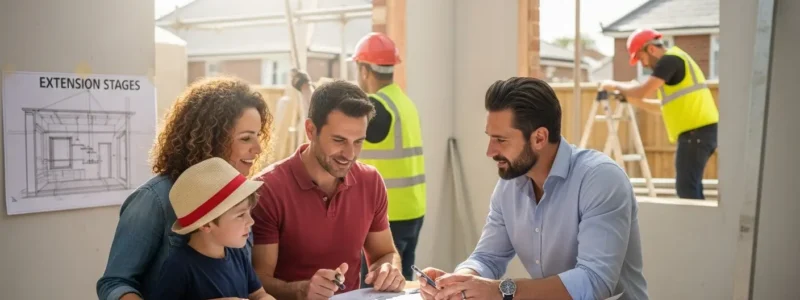Nearly 30 percent of London homeowners consider extending their property in the next five years, drawn by the potential to add value and create more space. With house prices soaring, building an extension has become a practical solution to changing family needs. Careful planning ensures your vision aligns with local guidelines and a realistic budget, setting the stage for a smooth and successful project.
Quick Summary
| Key Point | Explanation |
|---|---|
| 1. Set clear goals and budget | Define what problem you’re addressing and ensure your budget aligns with your vision to avoid overspending. |
| 2. Understand planning permissions | Not all extensions require full planning permission; review local regulations to save time and avoid issues. |
| 3. Choose skilled professionals | Select experienced architects and builders familiar with London’s regulations to ensure a smooth project execution. |
| 4. Develop detailed designs | Create precise architectural drawings that comply with building regulations and incorporate your design vision. |
| 5. Monitor construction closely | Actively oversee the build process through regular site visits to ensure quality and adherence to plans. |
Table of Contents
- Step 1: Assess Your Extension Goals And Budget
- Step 2: Consult Local Planning Regulations And Permissions
- Step 3: Select A Design And Construction Team
- Step 4: Develop Detailed Designs And Obtain Approvals
- Step 5: Oversee Construction And Monitor Quality
- Step 6: Verify Completion And Ensure Satisfaction
Step 1: Assess your extension goals and budget
Planning a home extension in London starts with crystal clear goals and a realistic budget. This initial step helps transform your vision from a dream into an actionable project that matches your property’s potential and your financial constraints.
Begin by asking yourself some fundamental questions. What specific problem are you solving? Perhaps you need more kitchen space for family gatherings, want a home office, or dream of an open plan living area. According to the planning guidance for home improvements, understanding your core objectives will help align your design with practical constraints.
Next comes the financial reality check. London extension costs typically range between £1,300 and £2,100 per square metre for single storey projects, with two storey extensions costing between £1,500 and £2,500 per square metre. These figures aren’t just numbers they represent potential transformations of your living space. Consider factors like material quality, construction methods, and any unique site challenges that might impact your budget.

Here’s a summary of typical home extension costs in London:
| Extension Type | Cost per m² (Low) | Cost per m² (High) |
|---|---|---|
| Single storey | £1,300 | £2,100 |
| Two storey | £1,500 | £2,500 |
| Contingency fund (recommended) | +15% of total estimate | +15% of total estimate |
Pro Tip: Always add a 15% contingency fund to your initial budget estimate. Unexpected expenses are more common than you might think.
Research local precedents by reviewing planning authority databases and examining neighbouring properties. This strategy helps you understand what extensions are feasible in your specific area and can provide inspiration for your own project. You will gain insights into design possibilities and potential planning permission requirements.
Finally, prioritise your must haves versus nice to haves. Can you compromise on high end fixtures to allocate more budget towards structural improvements? Being flexible and strategic will help you create a more achievable extension plan.
In the next step, you will translate these goals and budget considerations into a preliminary design that brings your vision closer to reality.
Step 2: Consult local planning regulations and permissions
Undertaking a home extension in London requires navigating a complex landscape of planning regulations and permissions. This step ensures your project complies with local guidelines and avoids potential legal complications that could delay or halt your renovation.
Many homeowners are surprised to learn that not all extensions require full planning permission. Understanding the planning permission requirements can save you significant time and stress. According to the Planning Portal, numerous extensions fall under permitted development rights within specific size and placement limits. However this does not mean you are completely free from regulatory oversight.
Even if your project qualifies as permitted development you will still need Building Regulations approval. This process ensures your extension meets critical safety standards for structural integrity electrical systems insulation and accessibility. The key is understanding the specific parameters that govern your particular property and planned extension.
Pro Tip: Always check your specific property status. Conservation areas and listed buildings have stricter rules that might significantly impact your extension plans.
For larger single storey rear extensions that extend beyond standard permitted development limits you will need to go through a ‘prior approval’ process. This involves consulting with your local authority and neighbours to assess potential impacts on amenity and neighbouring properties. The local planning department will evaluate factors like potential overshadowing loss of light and overall visual impact.
If you share a wall with neighbours your project may also trigger the Party Wall Act requirements. This means you must formally notify and potentially negotiate agreements with adjacent property owners before commencing construction.
Careful early consultation can prevent costly mistakes. Speak with your local planning authority early gather all necessary documentation and be prepared to provide detailed plans and impact assessments.
In the next step you will transform your initial concept into a detailed design that meets all regulatory requirements while bringing your vision to life.
Step 3: Select a design and construction team
Selecting the right design and construction team is crucial to transforming your extension vision into reality. This step involves finding skilled professionals who understand your goals and can navigate the complex landscape of London home improvements.
Work with architects and builders seamlessly by starting with professional directories. According to the Planning Portal recommendations seek professionals through established bodies like the Chartered Institute of Architectural Technologists (CIAT) Federation of Master Builders (FMB) and Royal Town Planning Institute (RTPI). These organisations provide vetted directories of experienced professionals who specialise in residential extensions.
For single and two storey extensions you will need a combination of specialists including structural engineers architects and potentially planning consultants. Each professional brings unique expertise critical to creating a successful extension project. An architect can translate your vision into practical design while a structural engineer ensures your extension meets critical safety and building regulation requirements.
Pro Tip: Request comprehensive portfolios and speak with previous clients to understand each professional’s approach and reliability.
When evaluating potential team members consider their experience with London properties. Local knowledge matters significantly when dealing with complex urban planning regulations and specific neighbourhood constraints. Some professionals offer planning consultancy calculators to help you estimate potential professional fees transparently.
Financial considerations are equally important. Get detailed written quotes from multiple professionals comparing not just cost but also proposed timelines experience and included services. A slightly higher upfront investment can often save significant money and stress during the actual construction process.
Look for teams that offer end to end support from initial design through planning permission and final construction. This integrated approach reduces communication gaps and potential misunderstandings.
In the next step you will collaborate with your chosen team to develop a detailed design that brings your extension dream to life.
Step 4: Develop detailed designs and obtain approvals
Developing detailed designs transforms your extension concept from imagination into a tangible blueprint that meets legal and structural requirements. This critical stage bridges your initial vision with practical architectural and regulatory specifications.
Your design must address comprehensive technical considerations mandated by Building Regulations. Understanding house extension approval processes becomes crucial as you navigate complex requirements. According to Redbridge Council guidelines your detailed designs must meticulously cover fundamental elements including foundation type structural walls floor configurations drainage systems electrical installations heating solutions window specifications ventilation approaches and roof construction.
Engaging local planning authorities early can significantly streamline your approval journey. Many councils offer pre application advice services where you can obtain informal guidance or receive formal written responses about your proposed extension. These consultations typically cost around £319 and provide invaluable insights into potential design modifications or compliance challenges.
Pro Tip: Invest time in creating extremely precise architectural drawings. Detailed documentation reduces potential delays and demonstrates professional preparation.
Work closely with your architectural team to ensure every technical aspect meets regulatory standards. This means developing drawings that not only look aesthetically pleasing but also demonstrate structural integrity energy efficiency and compliance with local planning guidelines.
Consider requesting multiple design iterations that balance your aesthetic preferences with practical building constraints. Your architect should help you navigate compromises between your original vision and regulatory requirements ensuring the final design is both beautiful and compliant.
Remember that obtaining approvals is not just about submitting paperwork. It is about presenting a comprehensive well thought out proposal that addresses potential concerns proactively. Anticipate questions local authorities might have and provide clear explanatory documentation.
In the next step you will prepare for the actual construction phase transforming these detailed designs into a physical extension of your home.
Step 5: Oversee construction and monitor quality
Oversight during construction transforms your carefully planned extension from blueprint to reality. This crucial stage demands active engagement to ensure your project meets design specifications quality standards and regulatory requirements.
Save time and money with our clear design build process by maintaining consistent communication with your construction team. According to Redbridge Council guidelines Building Control will monitor critical construction elements including foundations structural integrity insulation safety glazing ventilation and roofing. However your personal oversight remains essential.
Regular site visits are your primary tool for quality monitoring. Plan to be present at key construction milestones such as foundation laying structural framing and first fix electrical and plumbing installations. These checkpoints allow you to verify that work matches your approved designs and identify potential issues early.
Pro Tip: Document every stage with photographs. These visual records can help resolve potential disputes and serve as valuable references throughout the project.
Consult local precedents and previously approved extension schemes in your neighbourhood. The Planning Portal recommends using successful local examples as benchmarks for understanding typical construction quality and compliance standards. This approach helps you set realistic expectations and recognize exceptional or substandard workmanship.
Maintain open dialogue with your project manager and construction team. Ask questions request detailed explanations of technical processes and ensure transparency about any unexpected challenges or proposed modifications. Your proactive engagement can prevent misunderstandings and potential costly rework.

Be prepared for periodic inspections by Building Control officers. Their professional assessments validate that your extension meets all safety structural and regulatory requirements. Cooperate fully provide requested documentation and address any recommendations promptly.
In the final step you will complete final inspections and prepare to enjoy your transformed living space.
Step 6: Verify completion and ensure satisfaction
Congratulations on reaching the final stage of your home extension journey. This concluding phase transforms your months of planning and construction into a tangible living space that reflects your vision and meets all regulatory standards.
Understanding the house extension approval process becomes critically important during final verification. According to Redbridge Council guidelines you must secure comprehensive Building Regulations approvals that confirm your extension meets stringent standards for structure energy efficiency safety and ventilation.
Pay particular attention to electrical works which require a specific Part P compliance certificate. This documentation validates that all electrical installations have been completed to professional standards protecting your home and family from potential electrical hazards.
Pro Tip: Request comprehensive handover documentation including warranties technical specifications and maintenance guidelines for all new installations.
Waltham Forest Council recommends utilizing post completion advice services to resolve any final discrepancies. Schedule a thorough walkthrough with your construction team documenting every detail. Look closely at finishing touches such as paintwork tiling electrical fixtures plumbing connections and overall aesthetic alignment with your original design concept.
Be methodical in your final inspection. Check that every aspect of the extension functions as intended. Test electrical switches heating systems windows doors and any integrated technologies. Verify that the space meets both your practical requirements and aesthetic expectations.
Ensure you receive all necessary certifications including completion certificates from Building Control. These documents are crucial for future property valuations insurance purposes and potential resale. They demonstrate that your extension has been professionally executed and meets all regulatory requirements.
Your home extension journey concludes with enjoying the transformed living space you have carefully planned designed and brought to life.
Unlock a Seamless London Home Extension Journey
Turning your home extension dream into reality in London often feels complex. You have clear goals and ideas, but the journey is filled with questions around planning regulations, design clarity, budgeting, and ensuring everything is done right first time. Navigating local authority requirements, securing planning permissions, and keeping a project on track can easily become overwhelming.
Instead of taking risks with your investment, trust a specialist who understands every detail of the process. Explore our expert insights in Planning & Permissions for Home Extensions, designed to help you avoid the common pitfalls highlighted above. If you value experienced project support, our Project Management for Home Extensions services ensure your extension is delivered smoothly, on budget, and with complete transparency. Ready to secure your new living space? Reach out now using our contact form and take advantage of our tailored advice and transparent pricing. Do not delay if you want to transform your London home with confidence and a trusted local partner.
Frequently Asked Questions
How do I assess my home extension goals?
To assess your home extension goals, start by identifying specific needs such as more space for a kitchen, a home office, or an open plan living area. Write down your objectives to clarify what you want to achieve and make your vision actionable.
What is the average cost of a home extension in London?
The average cost of a home extension in London typically ranges from £1,300 to £2,500 per square metre, depending on whether it’s a single or two-storey extension. Create a rough budget based on these figures to align your financial planning with your extension goals.
How do I determine if my extension needs planning permission?
To determine if your extension needs planning permission, check if it falls under permitted development rights or requires full planning approval. Review local guidelines carefully to understand specific size and placement limits that apply to your property.
What should I look for when selecting a design and construction team?
When selecting a design and construction team, prioritize professionals with experience in London property extensions and check their credentials. Gather detailed quotes from multiple teams to compare costs, timelines, and services before making your decision.
How can I ensure my home extension meets building regulations?
To ensure your home extension meets building regulations, develop detailed plans that adhere to all structural, electrical, and safety standards. Consult with your design team early in the process to address potential compliance issues and submit accurate documentation.
What steps should I take to verify the completion of my home extension?
To verify the completion of your home extension, conduct a thorough final inspection focusing on quality of finishes and ensuring all systems function properly. Request all necessary documentation, such as completion certificates and warranties, to safeguard your investment.





